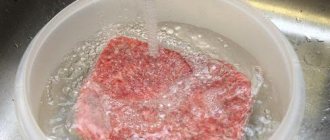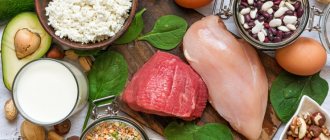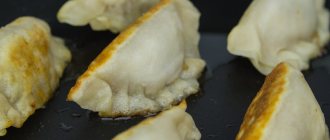How to defrost meat correctly
The best option is to transfer the meat from the freezer to the refrigerator at least a day before cooking. The temperature difference will not be so sharp, which means the meat will retain its structure.
Many people defrost meat using the microwave, but this is one of the worst options. First of all, those layers that are located closer to the edges thaw, and the central part remains frozen.
If you try to reheat the central part and put the meat in the microwave again, the juice from the already thawed parts begins to evaporate. Thus, when defrosting meat in the microwave, you practically destroy its juiciness and taste.
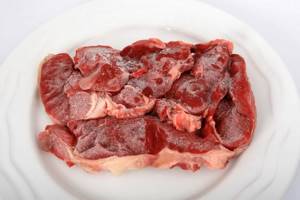
The best way to replace the microwave is as follows: place the bag of meat in a metal pan, and place another one on top. Now pour hot water into the top vessel. The metal will gradually absorb heat, the temperature difference will not be so sharp, which means the meat will retain its amazing taste.
How to defrost food correctly
Freezing foods helps us preserve them in almost their original form and then enjoy them in all their delicious glory. The freezer usually contains everything you might need, from meat to seasonal vegetables. The most important period for freezing is considered to be summer or spring, when we try to preserve as much food as possible that will have to wait until the next season. True, absolutely everything can be frozen and it doesn’t require any work, but it needs to be defrosted correctly so that the product does not spoil and turn the dish into a disgusting mess.

First, you need to remember one rather simple, but at the same time important thing - meat needs to be frozen quickly, but defrosted slowly in order to avoid loss of taste and other necessary properties. The best option is defrosting on the bottom shelf of the refrigerator about a day before cooking, if the meat itself is whole and weighs 2 kilograms. Afterwards, rinse it under running water and dab it with a paper towel. It is highly undesirable to defrost it in the air, since such an environment is especially favorable for pathogenic bacteria to reproduce. In the case of game, you need to do the same thing as with red meat. You can also simply dip the bird in the bag directly into water to defrost.
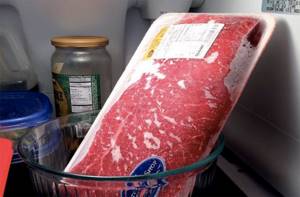
Fish and seafood are also no different in their defrosting system. The only thing you need to remember is that you cannot defrost them in warm or hot water, since such a procedure will completely deprive them of all their beneficial properties. You should just leave the seafood on a plate and place it on the lowest shelf, then drain all the water and cook immediately, since they have a very short shelf life after defrosting. The same can be said about minced meat, which after defrosting is only 24 hours old.
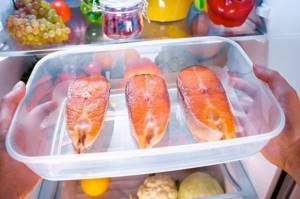
As for vegetables, berries and fruits, under no circumstances should they be left to defrost at room temperature, since all vitamins and juices will simply melt, like ice. It is best to throw them into dishes already frozen. For example, greens and some types of vegetables can be tossed in while cooking soup, and berries can be added to boiling water to make jelly or compotes. Thanks to this technique, the loss of nutrients is significantly reduced. As for other vegetables, fruits and berries that you cannot add to dishes, but need to be defrosted, in this case, the bottom shelf of the refrigerator will again help, because natural defrosting is much better than any other.
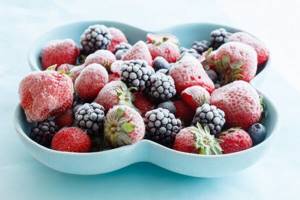
How to defrost vegetables
It doesn’t matter at all whether you bought ready-made frozen vegetables or are trying to defrost produce from your own garden. There is no need to take vegetables out of the freezer in advance - remember about the sudden temperature change?
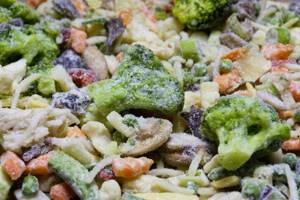
Immediately before cooking, add ice-cold vegetables to the dish - this way you will retain most of the nutrients. The most you can do is run cold water over the vegetables you just took out of the freezer and then add them to the dish.
What and how best to freeze
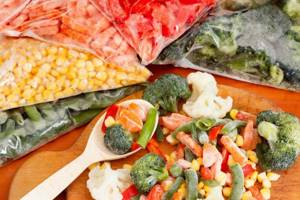
Freezing food is one of the popular types of preservation both on an industrial scale and at home. The difference is that vinegar, salt and sugar are not used, as in conventional canning.
When frozen, a lot of vitamins in vegetables, berries and fruits are preserved - for example, during industrial freezing this percentage reaches 80%, and when freezing at home - 60%.
Freezing vegetables and fruits is a significant saving for the family budget. Especially in winter, when prices for fresh vegetables and fruits in the markets skyrocket. Freezing vegetables and fruits has another important advantage for housewives - the cooking process requires much less time.

With the modern pace of life, housewives increasingly have to use frozen semi-finished products to quickly feed their family. If you prepare frozen homemade semi-finished products in advance, this will save cooking time. It should be added that semi-finished products prepared by yourself are much safer than those semi-finished products with dubious composition that are sold in the nearest supermarket.
But all these advantages of freezing will only occur if it is carried out correctly. What rules should be followed when freezing individual products?
Meat
When freezing, it is recommended to divide the meat into portions, wrap it in parchment paper and then put it in the freezer.
Fish
The fish must first be cleaned of scales and giblets. Before freezing, it is advisable to glaze the fish with water, this is done to prevent the product from drying out.
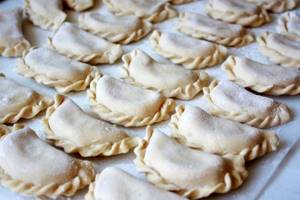
Homemade dumplings, dumplings, hedgehogs, meatballs, cabbage rolls, meatballs
First, all these semi-finished products need to be frozen on a cutting board, put into a bag and only then put in the freezer. All these semi-finished products should be prepared without prior defrosting.
How to freeze vegetables and fruits
Vegetables and fruits are pre-peeled, cut into the desired size and laid out on a cutting board. It is very convenient to freeze different vegetables in a mixture, which are good for making soups and other dishes. Vegetables are also prepared without defrosting.
Freezing berries
The berries must be sorted and frozen in bags. When preparing pies, porridges or compotes, berries do not need to be defrosted. If you need to defrost the berries, it is better to do this by placing the bag of berries in cold water and waiting for it to thaw. This way, defrosted berries will retain their shape, taste and aroma.
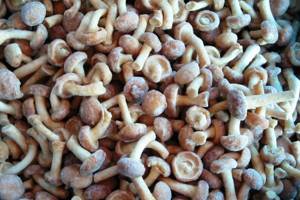
How to freeze mushrooms
First, all the mushrooms are sorted, washed several times and cooked for 20 minutes (in second water). Boiled mushrooms should be drained in a colander, cooled and placed into bags. You can also freeze chopped mushrooms in ice cube trays. Chopped mushrooms can be perfectly used in the preparation of certain dishes to give them a mushroom flavor.
Frozen spring rolls
Cooked and cooled pancakes need to be wrapped in cling film and only then transferred to a container for freezing. Frozen spring rolls can simply be reheated if necessary.
Ice jam
You can prepare berries or fruits, crushed in a blender or grated with a small amount of sugar, or a mixture of berries in the freezer, without resorting to cooking. It turns out to be a kind of ice jam. It can be frozen in plastic containers, bags or cups. If necessary, use a spoon to take out the required amount of jam, and put the rest back into the chamber. It is not recommended to freeze berry jelly, since at low temperatures it loses its texture (crystallizes).
As you can see, you can prepare frozen homemade semi-finished products from almost any product. The exception is pasta and potatoes; they do not tolerate negative temperatures well due to their high starch content. After freezing, potatoes and pasta become tasteless and change their texture.
How to defrost greens correctly
To freeze greens, wash them and let them dry, then put them in the freezer without cutting them. However, before adding frozen greens to food, do not defrost or wash them.
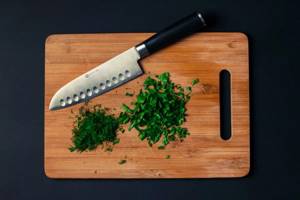
It’s better to take out a bunch of greens, cut off as much as you need, and put the rest back. Yes, chopping frozen parsley (and other herbs) will not be very easy, but it will retain most of the nutrients and will look more attractive in the dish.
Basic Rules
Self-freezing of fruits, vegetables and mushrooms for the winter is currently actively practiced and gaining momentum. Moreover, if you freeze eggplants correctly, they will retain the maximum amount of microelements important for health. Let's figure out how to properly freeze eggplants at home in the freezer for the winter.

- Selection of vegetable crops.
To freeze, you need to buy ripe fruits, with a uniformly colored and elastic surface without cracks or stains, since pathogenic microorganisms accumulate in them. It has been noticed that in young nightshades the level of harmful microelements is minimal.
- When storing in the freezer, avoid temperature changes.
At home, freezing eggplants for the winter involves packaging them in portions - for 1 cooking time. This is due to the fact that nightshade cannot be re-frozen. To freeze the product efficiently, the temperature at the storage location should not fall below – 12 degrees.
- Culinary experts recommend freezing blue fruits separately.
Therefore, if you plan to prepare a cocktail for stew, then pack the eggplants separately.
- Slicing and heat treatment is required.
Preparing eggplants for the winter and their subsequent freezing should be done in sliced form. This is due to the fact that the whole fruit will become rubbery in consistency, and in the absence of heat treatment, its taste will become bitter.
- When cutting vegetables, pay attention to the color of the cut.
If it is dark, then it is better to get rid of it, since there is an excess of a toxic substance inside - solanine. Dark spots can be cut out with a knife. Remember, a healthy nightshade should have a light cut.
- Control of deadlines.
Before freezing the cuts, prepare not only storage containers, but also notes with the date and name of the stock for the winter, so as not to expire its expiration date. It is worth noting that the shelf life of eggplants in frost conditions is 180 days.
- Container for freezing.
The main thing is that the packaging material for eggplants for the winter is airtight. This will help avoid contact with air. For freezing, nylon containers or plastic bags are perfect.
How long can frozen vegetables be stored?
We advise you to disassemble your freezer more often, because, despite the myth that food can be stored in the freezer for years, this is far from the case. Poultry can be stored “in ice” for six months - after which it will begin to lose all its beneficial qualities and acquire an unpleasant aftertaste.

Meat can be stored for a very long time - almost a year. Bell peppers, grated carrots, celery, cooked eggplants and fried tomatoes can also be stored for a long time, but for this you need to pack them in separate bags, from which all the air must first be released.
Remember that not all food should be stored in the refrigerator. There are some types of food that lose their beneficial properties when exposed to low temperatures.
How to defrost food correctly?
It is very convenient to store food frozen for a long time. But before cooking, it is important to defrost them correctly so that meat, fish, poultry, fruits, vegetables, and herbs do not lose their valuable properties and appearance. For this process, it is important that everything goes as slowly as possible. In this case, the maximum of useful substances is preserved. We invite you to learn about which defrosting methods are best to use for certain products.
Defrosting meat
One of the most successful and correct ways to defrost meat is to place it on the bottom shelf of the refrigerator. To properly defrost meat, just leave it in a bowl for several hours. The time it takes to defrost meat directly depends on the size of the piece. If its weight is about 2 kg, defrosting will take about 10 hours. If you are defrosting portioned pieces, then defrosting will take about three hours. If you need to defrost the minced meat to prepare a certain dish, then it is also kept on the bottom shelf of the refrigerator for about two hours until it is completely defrosted.
You can defrost meat at room temperature, but in this case, bacteria actively multiply on the surface and inside the product.
Very often, housewives defrost meat in water, but to prevent beneficial substances from being washed out of the meat, it must be placed in hermetically sealed polyethylene. It is better to use warm water, since cold or hot water destroys the proteins of the surface layer, deteriorating the appearance, taste and quality of the product.
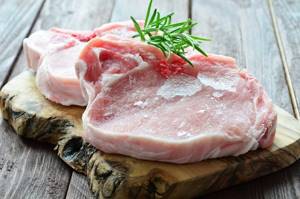
Despite the fact that the microwave oven has a “defrosting” mode, it is not recommended to defrost meat using it. You can use this function only when quick defrosting is more important than changing the quality of the product.
After the meat is completely defrosted, it must be rinsed under running water and the remaining moisture removed with a cotton napkin. If the meat is defrosted correctly, the top layer and the middle of the piece will be equally moistened, the entire piece will have a uniform color and a fairly elastic structure. The meat should exude a fresh aroma. When the meat is defrosted, it is advisable to cook it immediately.
It is important to remember that re-freezing meat that has already been thawed is strictly prohibited.
Defrosting the bird
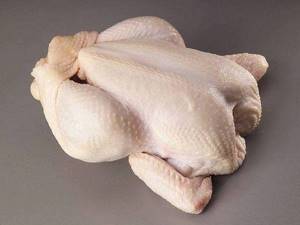
The process of defrosting poultry is similar to that for meat, preferably on the bottom shelf of the refrigerator. Defrosting in water is allowed by placing poultry meat in a tightly closed plastic bag. After the bird is defrosted, it needs to be cooked immediately.
Defrosting fish and seafood
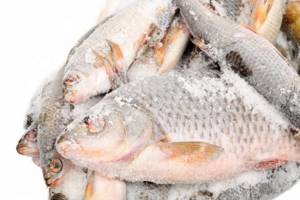
Fish is usually sold frozen. It is processed directly on fishing vessels. After buying fish, all that remains is to defrost it properly to prepare a delicious dish.
For fish, the ideal defrosting is natural thawing. To do this, remove the fish from the freezer and place it in a bowl, leaving it on the bottom shelf of the refrigerator.
Whole frozen fish can be thawed in cool water, using two liters of water and two tablespoons of salt for each kilogram of product.
The fillet must be thawed without water, since the beneficial elements of the product are washed out, the structure of the fillet changes, and with it the taste of the fish. Warm and hot water is generally contraindicated - valuable substances dissolve in it, and in addition, the fillet absorbs water, which leads to a deterioration in the quality of the dish.
It is not recommended to defrost fish at room temperature, since in such conditions bacteria multiply quickly and deteriorate the taste of the product.
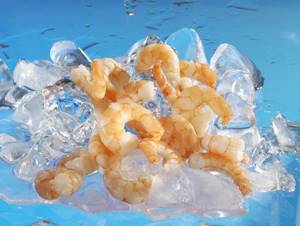
After the fish is defrosted, remove the packaging, squeeze out the accumulated liquid, and remove the remaining moisture with a paper towel.
Fish, unlike meat, may not be completely defrosted, in which case the finished dishes turn out more juicy.
The best way to defrost seafood is on the bottom shelf of the refrigerator. Cooking without complete defrosting is also allowed.
It is better to cook semi-finished fish products without defrosting them. Place the pan on low heat, increasing it gradually during cooking.
The main sign of proper defrosting is the relatively small amount of juice lost during defrosting. When a large amount of juice is released, the defrosted product loses a lot of proteins, minerals and vitamins, and also loses its taste. It is better not to re-glaze fish, like meat.
How to defrost berries, fruits and herbs
To defrost fruits, berries or herbs, you just need to remove the required amount from the freezer, place it on a plate and leave it on the bottom shelf of the refrigerator for an hour.
These types of products can be thawed at room temperature, but such conditions contribute to an intense loss of juice and vitamins.
Defrosting with water should also be carried out only in waterproof bags, immersing them in slightly warm water. Typically this process takes about 30-40 minutes.
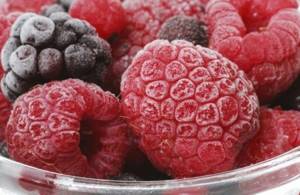
It is allowed to prepare dishes from berries and fruits without defrosting. At the same time, much more vitamins and microelements are preserved. If you need to prepare jelly or compote, it is better to put frozen fruits and berries in boiling water.
If you have a vegetable mixture with a small amount of ice in front of you, then you can not defrost it, but immediately add it to boiling water when preparing the first dish, or defrost it in a frying pan, gradually increasing the heat.
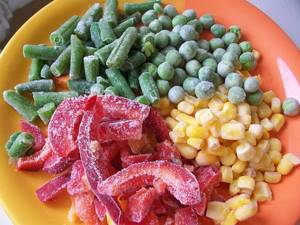
Greens can be added during the cooking process without first thawing, but immediately after removing them from the freezer.
Have delicious and healthy dishes!
Author: Ekaterina Sokolik
